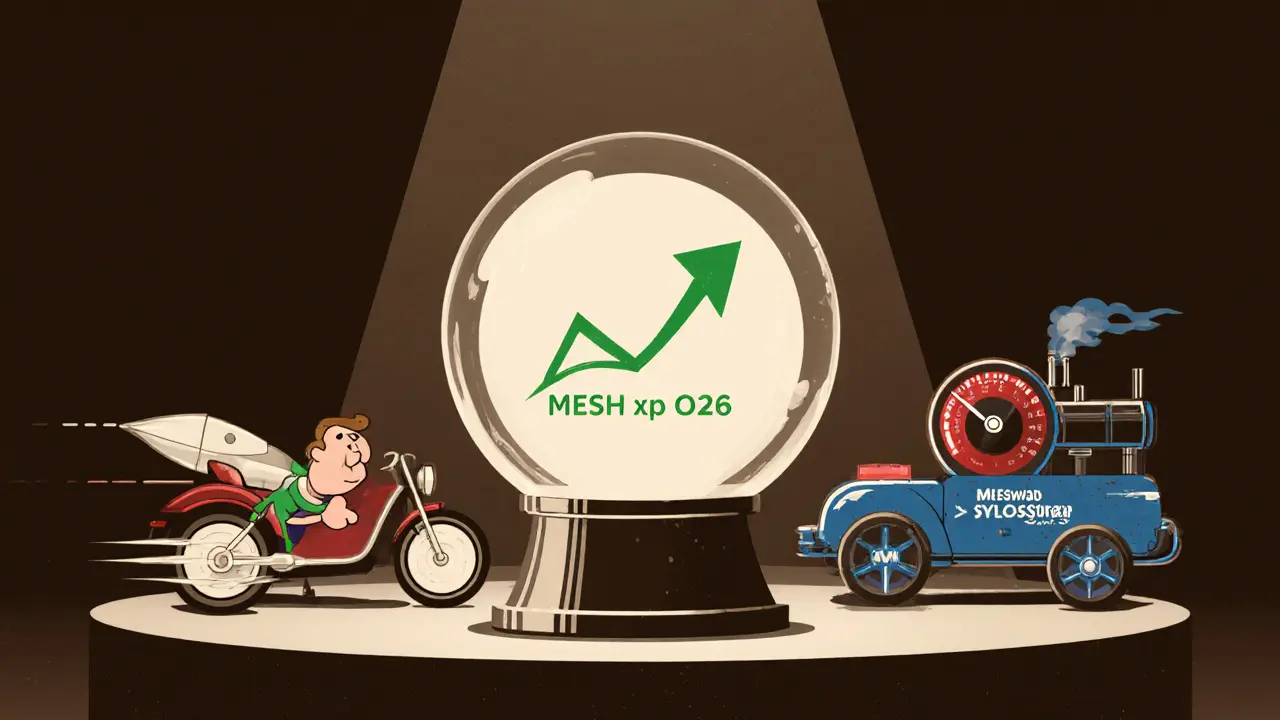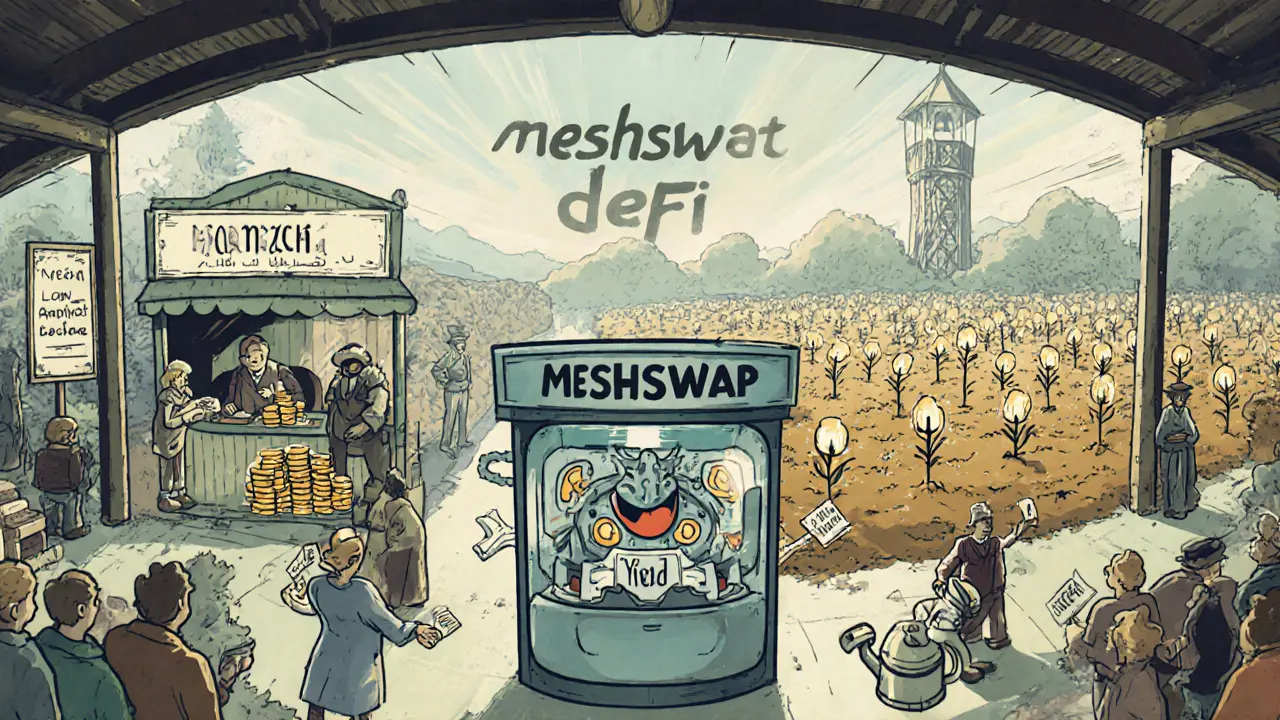MESH Token Price Simulator
Current Market Data
Current Price: $0.003324
All-Time High: $5.01
24-Hour Volume: $1,468.82
Circulating Supply: 71.41 million
Simulation Parameters
Projected MESH Token Price
Enter parameters and click "Calculate Future Price" to see projections
Important Note
This simulation is for educational purposes only and does not constitute financial advice. Cryptocurrency investments are highly volatile and risky. Past performance does not guarantee future returns. The actual price of MESH could be significantly different from these projections.
If you’ve been scrolling through DeFi dashboards and wonder whether Meshswap lives up to its hype, you’re in the right place. This review breaks down the platform’s core features, token economics, performance stats, and where the MESH token might be headed in 2025‑2026.
What is Meshswap?
Meshswap is a decentralized autonomous finance (DeFi) protocol on the Polygon network that combines an automated market maker (AMM) DEX with lending, leverage farming, and staking services. The platform markets itself as a “multichain economy” where community participation directly fuels token value and yield opportunities. Unlike many launchpads that rely on private sales, Meshswap used a fair‑launch model: the only way to acquire its native token, MESH, is by providing liquidity in the protocol.
Key Components and How They Fit Together
- Automated Market Maker (AMM) DEX: Users swap assets instantly without an order book. The AMM pools are funded by liquidity providers (LPs) who earn a slice of swap fees.
- Lending & Borrowing: Borrowers post collateral and receive loans in supported assets. Lenders earn interest that’s sourced from the borrowing side.
- Leverage Farming: Yield farms let users lock MESH or other tokens to earn inflation rewards. The platform burns a portion of MESH when new pools are created, creating a deflationary pressure.
- Staking & Governance: Holding vMESH (staked MESH) grants voting rights on distribution rates and grants airdrops from partner projects such as Ecopot.
Performance Snapshot (October2025)
| Metric | Value |
|---|---|
| Native token price | $0.003324 (USD) |
| All‑time high (2022) | $5.01 |
| 24‑hour volume | $1,468.82 |
| Daily price range | $0.003276 - $0.003341 |
| Liquidity pool split (USDC.E / WPOL) | ≈50% each |
| Transaction speed (estimate) | ~120seconds (Polygon‑layer) |
Despite a modest daily volume, CoinMarketCap flags Meshswap as an “untracked listing,” meaning the data may not be fully reliable. The platform’s transaction speed lags behind leading AMMs like Uniswap (≈60seconds on Ethereum) and Symbiosis.finance (≈45seconds on Polygon).

MESH Tokenomics in Plain English
MESH token serves three core purposes: incentive, governance, and utility. Here’s how it breaks down:
- Supply: Total supply 122.94million, circulating ~71.41million.
- Inflation model: New tokens are minted each year and distributed to LPs, stakers, and farmers. Annual halving events curb inflation over time.
- Burn mechanic: Creating a new farming pool requires burning MESH, removing those tokens permanently.
- Governance: vMESH holders vote on reward rates and protocol upgrades. Voting power is proportional to staked amount.
Because acquisition is tied to liquidity provision, early participants enjoyed higher yields. However, the token’s price has plunged 99.9% from its peak, leaving many early investors with deep losses.
Pros and Cons - A Practical Checklist
- Pros
- All‑in‑one DeFi suite on a low‑fee network (Polygon).
- Fair‑launch distribution - no private sales.
- Burn‑on‑creation mechanic adds a deflationary element.
- Staking rewards are paid in newly minted MESH, boosting yields for long‑term holders.
- Cons
- Very low trading volume and “untracked” status raise transparency concerns.
- Transaction speed slower than top AMMs, potentially hurting user experience.
- Token price remains near all‑time low despite broader market rallies.
- Limited public audits or security reports - a red flag for risk‑averse users.
How Does Meshswap Stack Up Against Major AMMs?
| Feature | Meshswap | Uniswap V3 (Polygon) | Symbiosis.finance |
|---|---|---|---|
| Average swap time | ~120seconds | ~60seconds | ~45seconds |
| 24‑hr volume (USD) | $1,468 | $12.3M | $9.8M |
| Liquidity (USDC/E) | ≈$0.5M | $4.2M | $3.7M |
| Governance token | MESH | UNI | SYMB |
| Audit status | Not publicly disclosed | Audited by CertiK | Audited by PeckShield |
The numbers make it clear: Meshswap is a niche player with limited liquidity and slower execution. If you prioritize deep pools and fast trades, Uniswap or Symbiosis are safer bets.
Price Outlook - What the Numbers Say
Price‑prediction aggregators paint a mixed picture. The average 2025 forecast hovers around $0.0010, implying a modest 3% return if you buy at today’s $0.0033 price. Some services, like WalletInvestor, are a bit more optimistic, targeting $0.0013 by year‑end. The outlook improves for 2026, with projected prices between $0.0012 and $0.0017, hinting at a potential 49% upside.
In plain terms, unless you believe the platform will attract fresh liquidity or roll out a major upgrade, the token is more likely to stay near its recent lows. Investors looking for speculative upside should size their position accordingly and be prepared for high volatility.

Security and Regulatory Snapshot
Meshswap’s smart contracts run on Polygon, inheriting the network’s proven security model. However, the project has not published a formal audit report from a known firm, which is a red flag for institutional users. Because the protocol is fully decentralized, regulatory responsibility falls on the user. No clear KYC/AML mechanisms exist, meaning you should treat the platform as a high‑risk, permissionless environment.
Should You Use Meshswap?
Answering this question depends on your objectives:
- If you want a one‑stop DeFi hub on a low‑fee chain and are comfortable with higher risk, Meshswap offers decent yields for LPs and stakers.
- If you prioritize security audits, deep liquidity, and fast swaps, you’re better off sticking with established AMMs.
- Speculators hoping for a MESH rally should only allocate a small portion of their portfolio, given the token’s steep decline from its peak.
Overall, Meshswap is an interesting experiment that showcases how a community‑driven token model can work-but it still has a long way to go before matching the performance and trust of the market leaders.
Quick Takeaways
- Meshswap runs on Polygon and combines swapping, lending, farming, and staking.
- MESH token price is $0.0033 (Oct2025), 99.9% below its 2022 peak.
- Low 24‑hr volume and untracked listing raise transparency concerns.
- Transaction speed (~120seconds) trails top AMMs.
- 2026 price forecasts suggest modest upside, but risk remains high.
Frequently Asked Questions
What network does Meshswap operate on?
Meshswap is built on the Polygon (formerly Matic) network, taking advantage of its low transaction fees and fast block times.
How can I earn MESH tokens?
You earn MESH by providing liquidity to swap pools, staking MESH (which gives you vMESH), and participating in leveraged yield farms. Each activity mints new MESH that is distributed based on the platform’s inflation schedule.
Is Meshswap audited?
The project has not released a public audit from a reputable firm, so users should treat the protocol as higher‑risk compared to audited platforms.
What are the main risks of using Meshswap?
Key risks include low liquidity (which can cause slippage), slower transaction speeds, lack of transparent audit reports, and the volatile price of the MESH token itself.
How does the MESH burn mechanism work?
When a user creates a new farming pool, a predefined amount of MESH is permanently burned. This reduces the circulating supply and, in theory, supports the token’s long‑term price.


Kate O'Brien
October 8, 2025 AT 09:13Looks like Meshswap is just another front for the big players to hide their moves. They say it’s community‑driven, but the low volume and untracked listing scream otherwise.
Ricky Xibey
October 10, 2025 AT 02:53Yo, the UI is pretty slick and the yields look decent if you’re okay with the slower swaps. Just make sure you don’t lock up too much if the price stays low.
Sal Sam
October 11, 2025 AT 20:33From a technical standpoint, Meshswap operates on a standard AMM model with liquidity provision incentives tied to token inflation. The burn‑on‑creation mechanic introduces a deflationary vector, yet the net token supply continues to expand due to yearly minting schedules.
Moses Yeo
October 13, 2025 AT 08:39Ah, but consider the philosophical implication of perpetual token inflation-does it not betray the very notion of scarcity that underpins value?; moreover, the platform’s latency hints at a deeper systemic inefficiency; one could argue that the entire architecture is a façade for capital extraction.
Lara Decker
October 14, 2025 AT 17:59Honestly, the numbers don’t lie: low volume, high slippage, and a price that’s stuck near its nadir. If you’re chasing yield, look elsewhere.
Anna Engel
October 16, 2025 AT 00:33Oh sure, because every DeFi project that “does a bit of everything” is automatically a goldmine. Let me guess, the next hype wave will lift MESH back to $5?
manika nathaemploy
October 17, 2025 AT 04:19i get that it looks cool on paper but real life is diff. if u can handle the risk, maybe give it a try, but dont put all ur coins in one basket.
Marcus Henderson
October 18, 2025 AT 05:19Meshswap presents an intriguing case study in the evolving landscape of decentralized finance, particularly within the Polygon ecosystem. Its ambition to consolidate swapping, lending, farming, and staking under a single protocol offers users a streamlined experience that, in theory, reduces friction and lowers transaction costs. The fair‑launch model, wherein MESH is obtained exclusively through liquidity provision, aligns incentives between early participants and the platform’s long‑term health. This design fosters a community‑driven tokenomics structure that can be admirable in a space often plagued by private pre‑sales and preferential allocations.
Nevertheless, the empirical data paints a more sobering picture. The current 24‑hour trading volume hovers around $1.5 k, a figure that starkly contrasts with the multimillion‑dollar daily volumes observed on leading AMMs such as Uniswap V3 on Polygon. Such thin liquidity inevitably leads to heightened slippage for traders, eroding the attractiveness of the DEX for larger swaps. Moreover, the reported average transaction time of roughly two minutes lags behind the sub‑minute execution times of competitors, potentially deterring users who prioritize speed.
The token’s price trajectory is equally concerning. From an all‑time high of $5.01 in 2022 to a present level of $0.0033, MESH has suffered a precipitous decline of over 99 %. While the burn‑on‑creation mechanism introduces a deflationary element, the ongoing annual inflation and modest minting schedules may offset any scarcity benefits. Consequently, speculative upside appears limited unless the platform can attract substantial new liquidity or unveil a transformative upgrade.
From a security perspective, the absence of a publicly disclosed audit is a non‑trivial risk factor. Institutional participants and risk‑averse investors typically demand third‑party verification to mitigate smart‑contract vulnerabilities. The current audit opacity, combined with the “untracked” listing status on major aggregators, raises legitimate concerns about data reliability and transparent reporting.
In conclusion, Meshswap embodies both the promise and peril of emerging DeFi projects. For users seeking diverse yield opportunities on a low‑fee network and who are comfortable with higher risk exposure, the platform may offer modest rewards. However, traders prioritizing deep liquidity, rapid transaction finality, and audited security should consider more established alternatives. As with any speculative asset, prudent allocation-ideally a modest fraction of one’s portfolio-is advisable.
Liam Wells
October 19, 2025 AT 03:33While the foregoing exposition extols many virtues, one must also contemplate the broader macro‑economic currents that render such decentralized endeavors vulnerable; the paucity of audited code, the lagging transaction throughput, and the stark liquidity deficit collectively suggest a systemic fragility that may outweigh purported benefits.
Nicholas Kulick
October 19, 2025 AT 22:59For anyone looking to dip a toe in, start by providing a modest amount of liquidity and monitor the APR. The platform’s staking rewards are transparent, but remember to factor in gas costs and potential impermanent loss.
Darren Belisle
October 20, 2025 AT 15:39Even with its current shortcomings, Meshswap could still carve out a niche for users who value an all‑in‑one DeFi suite on Polygon; patience and a willingness to experiment might reward early adopters with higher yields as the ecosystem matures.
Heather Zappella
October 21, 2025 AT 05:33The cultural relevance of a platform like Meshswap lies in its attempt to democratize token distribution, yet the technical execution must catch up with its ideological aspirations. Providing accurate, real‑time data would greatly improve trust among global users.
Jason Wuchenich
October 21, 2025 AT 16:39Remember, the best approach is to diversify-don’t allocate all your capital to a single protocol. Look for complementary platforms with stronger liquidity to balance risk.
Jack Stiles
October 22, 2025 AT 00:59Sounds like a risky play.
Ritu Srivastava
October 22, 2025 AT 06:33It is morally questionable to promote a service that lacks transparent audits while encouraging uninformed users to invest their savings. Ethics must come before hype.
Caleb Shepherd
October 22, 2025 AT 10:43There are whispers that the team behind Meshswap is linked to a larger consortium that manipulates token prices across multiple chains. Stay vigilant; the illusion of decentralization can mask coordinated control.
Mark Bosky
October 22, 2025 AT 14:03In evaluating Meshswap, it is essential to weigh both quantitative metrics and qualitative considerations. The current liquidity pool of approximately $0.5 M, when juxtaposed with a daily volume of merely $1.5 k, suggests a shallow market depth that could hinder large‑scale transactions.
The platform’s fee structure, which distributes a portion of swap fees to liquidity providers, does offer a modest incentive for capital deployment. However, given the prevailing low transaction throughput-averaging two minutes per swap-opportunity costs may outstrip potential rewards, particularly for users seeking timely execution.
From a tokenomics perspective, the MESH token’s inflationary schedule, coupled with a burn‑on‑creation mechanic, creates a nuanced supply dynamic. While burning tokens upon farm creation introduces a deflationary pressure, the overall net supply continues to expand due to annual minting. Consequently, price appreciation prospects appear constrained unless a substantial influx of new liquidity materializes.
Security considerations remain paramount. The absence of a publicly disclosed audit from a reputable firm introduces an element of risk that cannot be overlooked. Users should treat the protocol as high‑risk until a comprehensive audit is released and verified by independent auditors.
In summary, Meshswap may serve as a niche solution for users comfortable with higher risk tolerance and seeking exposure to a multi‑functional DeFi suite on Polygon. Prudence dictates a conservative allocation-ideally a small fraction of one’s overall portfolio-while awaiting clearer signals of liquidity growth, improved transaction speed, and verified security assurances.
Debra Sears
October 22, 2025 AT 16:49I understand the excitement around new DeFi platforms, but it’s important to stay grounded. If you decide to try Meshswap, consider setting clear exit strategies and keep a close eye on any updates regarding audits or partnership announcements.